9 August 2018
Inspection and Sampling of Test Lines and Pilot Mitigation Farms
Over the past two weeks, research personnel from the Danish Shellfish Center visited the 2018 mussel mitigation test sites: Sallingsund, Mariager Fjord, Vejle Fjord, Flensborg Fjord, and Roskilde Fjord. Biomass samples were captured to characterize total growth potential in these estuaries. The pilot farms in Dråby Vig and Skive Fjord were surveyed and also sampled for biomass distributions across the farms. At all sites, environmental parameters are being tracked (salinity/conductivity, temperature, chlorophyll-a, and turbidity) by frequent discrete sampling events and by continuous monitoring stations. Recruitment and growth of mussels appear positive at all sites, with some variation in minor interspecific settlement. Growth data will be tracked for the remainder of the growth season to evaluate the potential for mitigation farming in these eutrophic estuaries.
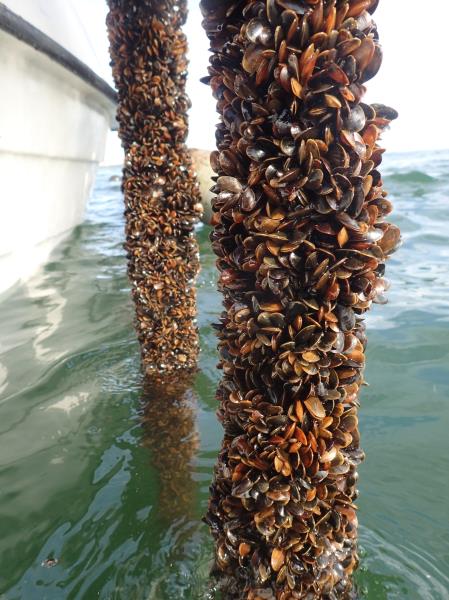
Mussel spat settled on collectors in Vejle Fjord
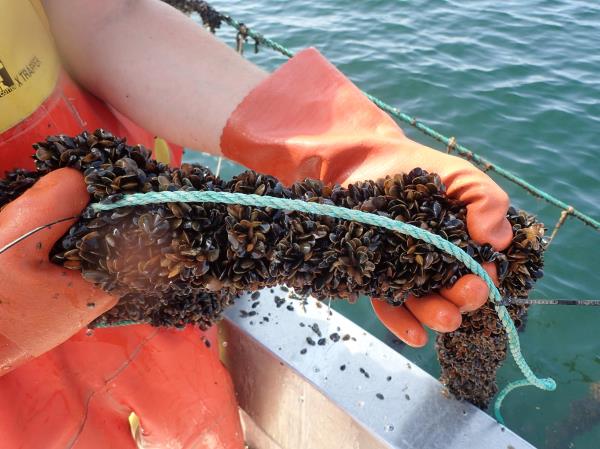
Sampling mussels for individual and growth and biomass on the collectors
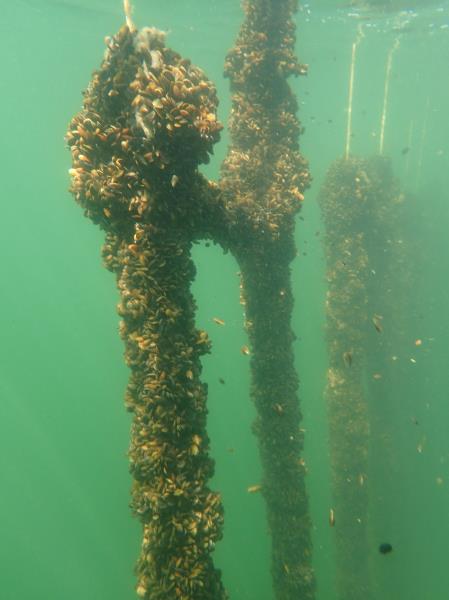
Spat collectors suspended in the water column
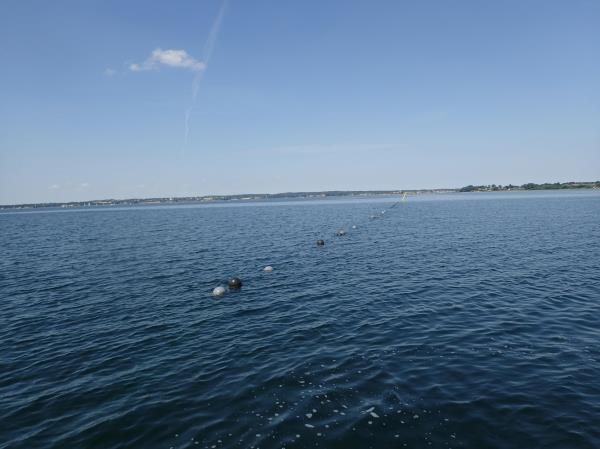
Test line in Flensborg Fjord
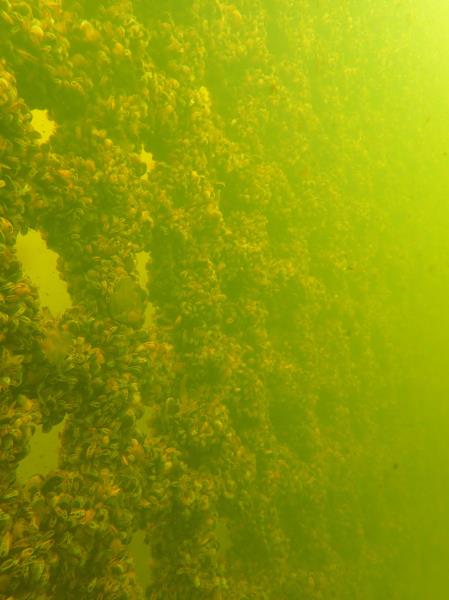
Mussels settled on nets in Skive Fjord, abundant food supplies!
10 May 2018
Mussel meal in feed for organic egg laying hens ready to start
The mussel meals are produced and feed formulations have been prepared for organic poultry. A total of 210 egg laying hens in an organic farm are ready to receive the diets. The hens are of the Lohmann Brown breed, and they are divided into 6 groups with each pen, feeding, egg collection and hen-yard facilities fulfilling the regulations for organic egg production. The first egg collection as the starting point was made today, and eggs are now analyzed for quality parameters with focus on the egg shell and egg yolk. This part of the study continues until end of September 2018.
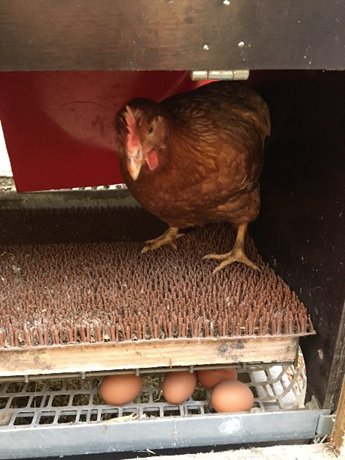
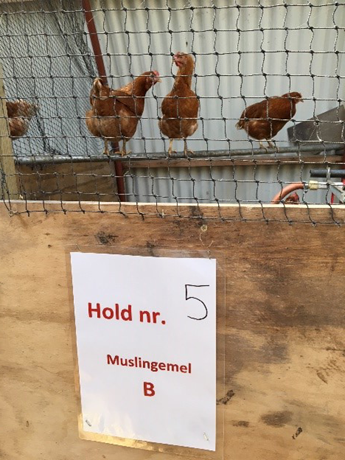
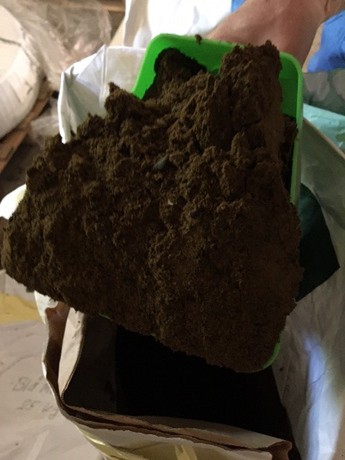
8-18 May 2018
Single test lines in various Danish Fjords
Yesterday was a lovely day in North Jutland and Egon P. left Nykøbing Mors for a two-week tour around the East Coast of Denmark. Our crew will setup some reference mussel longlines in 4 fjords (Mariager, Vejle, Roskilde, Flensburg). We will follow the growth and development of the mussels in the different fjords over a period of <12months. The results will be included in individual growth models and ecological models to calculate the potential use of mussel as mitigation measure to remove nutrients from the water in various Danish fjords. As you can see in the pictures, Egon P is heavily loaded with anchors and material to secure the lines
here are a few pictures of the line setup in Roskilde Fjord.
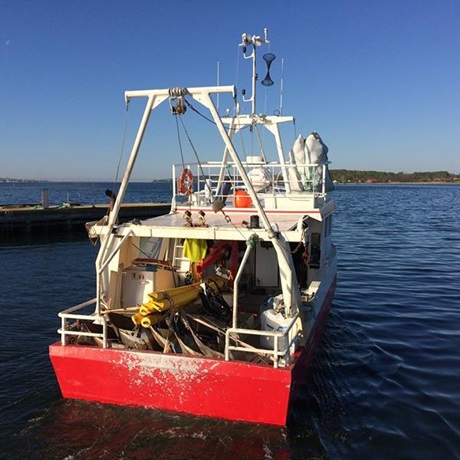
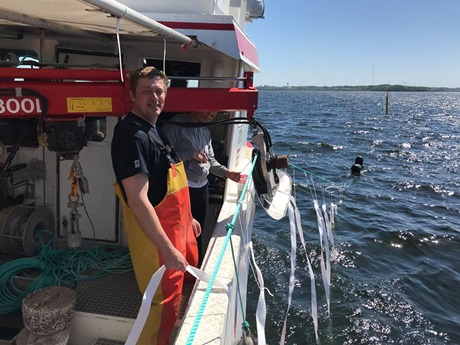
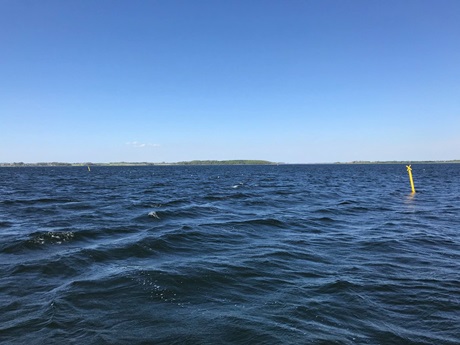
22 March 2018
Annual meeting hold in Nykøbing Mors
The four-year Innovation Fund Denmark MuMiPro annual meeting was held on the 22 March 2018. Most partners from the project were present, other could not attend the meeting as they were processing the freshly harvested mussels for the project. The project has a total budget of 2,9 million EUR and includes 15 partners from Denmark and Norway both from academia and industry.
19-23 March 2018
Second Mitigation Mussel Harvest
Finally the second mussels from MuMiPro mitigation test sites were harvested this week in cooperation with Seafood Limfjord and Wittrup Seafood from longlines established in the Limfjord sites with mussel spat collectors deployed in May 2017. The harvest occured slightly later than anticipated due to ice cover of the Limfjorden limiting access to the farms. As for November 2017, data will provide insight to each site´s production characteristics and mussel growth potential. Fresh mussels have been transferred to three different processing sites for processing the mussels into meal that will be tested this spring in feed studies.
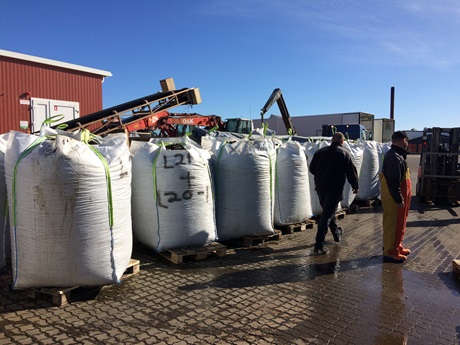
harvested mussels in bulk in big bags prior to the sorting, cleaning and processing
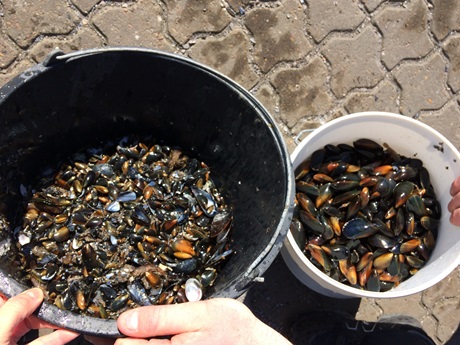
Sorted mussels: left side is the waste from the cleaning process, while on the right are the mussels that will be processed
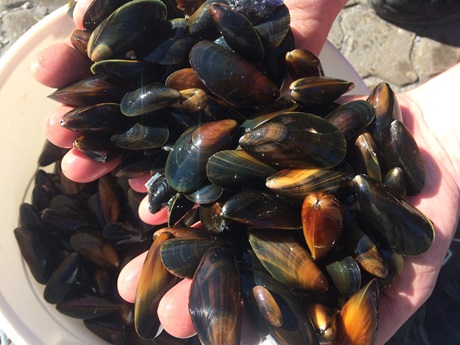
Cleaned mitigation mussels prior to processing
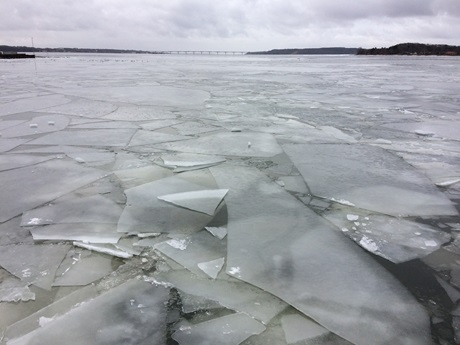
Large thick sheet of ice which have delayed the boat operations this February.
24 November 2017
Initial Mitigation Mussel Harvest
The first mussels from MuMiPro mitigation test sites were harvested this week in cooperation with Seafood Limfjord. Long-lines established in the Limfjord sites were prepared with mussel spat collectors in May 2017 to test a variety of configurations for optimizing biomass production. Harvest data will provide insight to each site's production characteristics and mussel growth potential, as well as input on configurations in 2018. High growth patterns and yields were observed after 6 months, indicating recruitment and growth at these sites could be promising for the development of large scale mitigation farming. Fresh mussels have been transferred for processing into meal and subsequent feed studies.
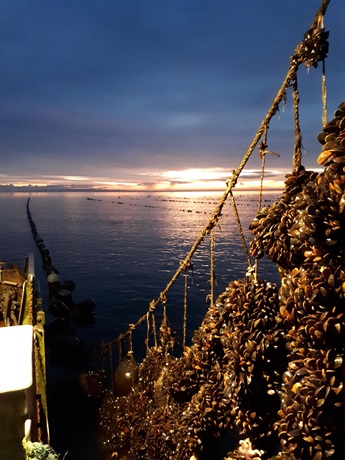
Mitigation Mussels ready for harvest
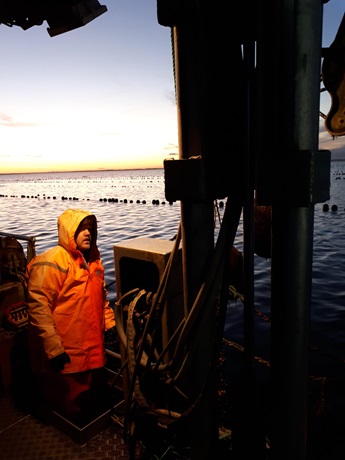
Industry partners harvesting Mitigation Mussels from Limfjorden
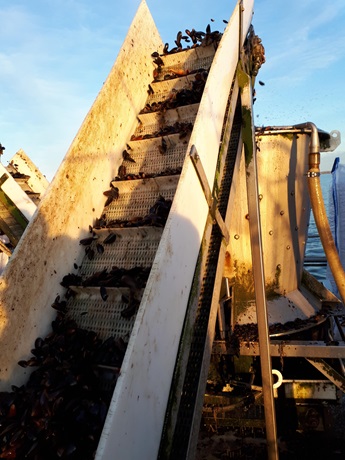
Conveying mussels from collectors to the declumper
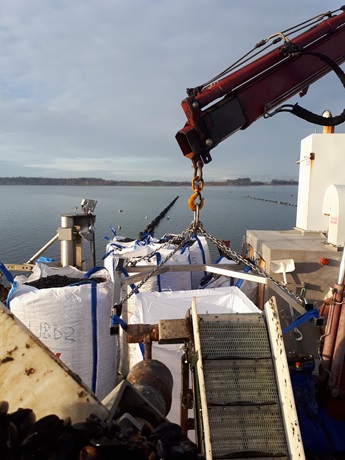
Conveying cleaned mussels to bags
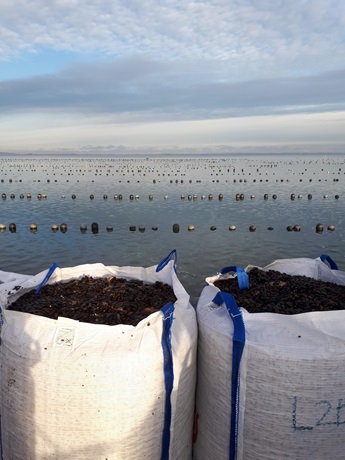
Bags of Mitigation Mussels, ready for transfer to processing facilities
1 October 2017
Tracking Biomass and Environmental Conditions at Mitigation Sites: Mariager Fjord
Following regular monitoring of environmental conditions and mussel growth on spat collectors deployed earlier this year, positive recruitment and growth is evident in Mariager Fjord. In contrast to the Limfjord and open seas, Mariager Fjord is considerably less saline (i.e. 26-35 PSU vs. 10-16 PSU), which is an important parameter for mussel physiology; nevertheless, these adaptive organisms are able to thrive in this environment. Mariager Fjord was once an archetype of enriched estuarine waters, as notoriously exemplified in the summer of 1997 when the water column throughout the fjord become anoxic. Tracking mussel biomass growth on the reference line as well as environmental parameters such as chlorophyll-a (a proxy for mussel food), temperature, salinity, and suspended matter at sites like Mariager Fjord will help MuMiPro scientists develop models to evaluate the potential for mitigation culture in multiple environments. Positive growth thus far indicates mitigation mussel culture could serve an important role in enhancing water quality in Mariager Fjord.
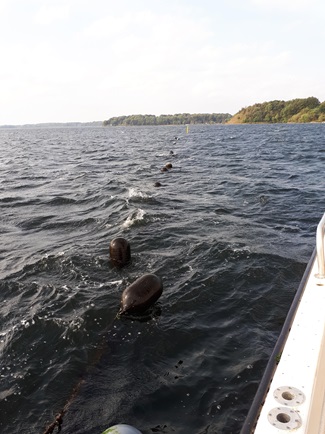
Reference Line in Mariager Fjord
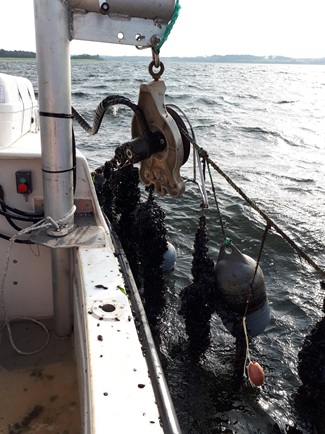
Running along the reference line to sample for biomass
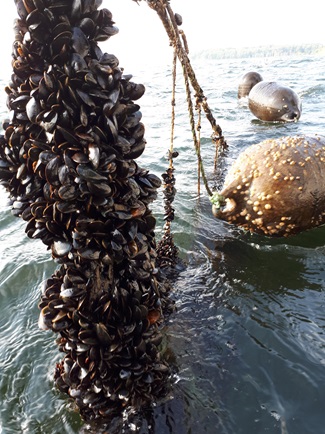
Dense mussel growth on the spat collectors
13 August 2017
Starfish Predation on Mussel Spat Collectors and Intervention
Larval settlement of the common sea star (Asterias rubens) on mussel spat collectors is a highly variable process influenced by local and inter-annual conditions. Successful metamorphosis of starfish on these collectors provides an advantageous environment for growth with such abundant food resources – mussel spat.
Starfish, left untreated, can rapidly consume a mussel population to an extent that results in food resource exhaustion; i.e. total depletion of mussel biomass. In addition, mussels respond with individual and communal adaptive behavior, which may lead to reduced growth and spatial aggregation patterns that can be detrimental to total yield – a cascade of negative effects.
There are indications to the efficacy of naturally mediated predation suppression and managed interventions, either pre- or post-settlement. Such mechanisms require further study to provide mussel farmers with the best tools to combat starfish predation. MuMiPro lines that have been impacted by starfish settlement this year, which has been reported to be high in the Limfjord, were studied and treated to remove starfish and maximize mussel biomass growth.
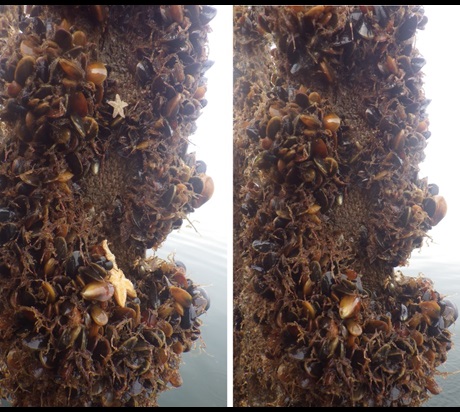
Mussels on collectors migrate in response to starfish presence; physical removal of starfish.
30 July 2017
Continuous environmental data acquisition and biomass sampling begins
As of this week, chlorophyll, turbidity, temperature, and salinity sensors are online and continuously logging at four mussel production sites: Løgstør Bredning, Skive Fjord, Sallingsund, and Mariager Fjord. This high-resolution data will facilitate modeling of mussel growth and mitigation potential. Sections of spat collectors have been collected to gather data on recruitment, density, and growth. Tracking growth and community compositions at each site will help to interpret site and husbandry-specific capabilities for mitigation culture.
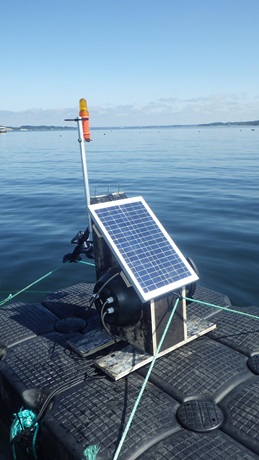
Sensor platform moored at the Skive Fjord farm.
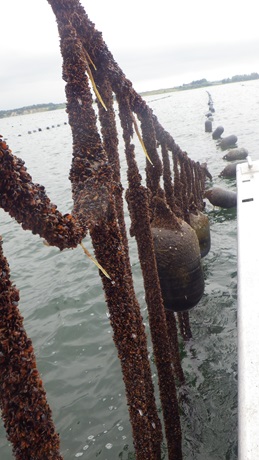
Mitigation line with collectors, mussels set and growing.
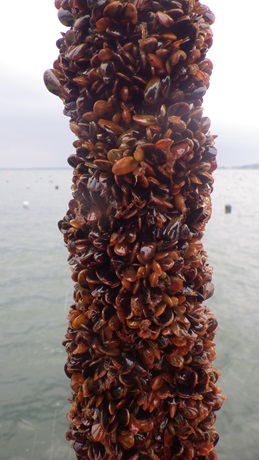
Collector section removed for sampling.
15 June 2017
Environmental monitoring has started for the mussel production
We have been collecting mussel larvae samples together with water samples for monitoring the environmental conditions at the various farms (salinity, temperature, chlorophyll a concentration, particulate matter). We will survey the mussel growth and density in the coming weeks, once the mussels attached to the spat collector will be visible.
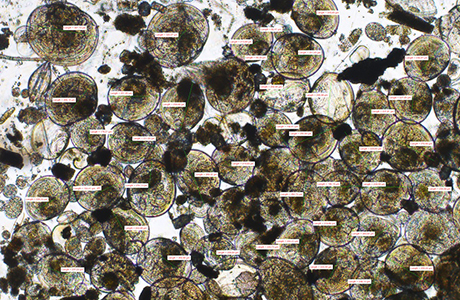
Example of mussel larvae measurements and counting from water samples taken at the various farms.
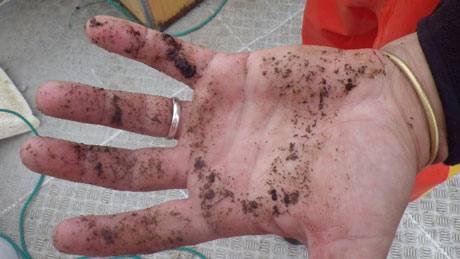
Skive farm: small mussels on spat collectors are already visible (small brown dots on the picture)
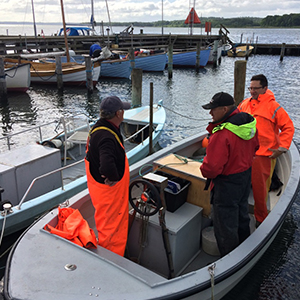
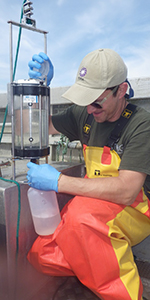
Left: Finn and Daniel going out sampling on Mariager Fjord with Finn Frandsen, our local caretaker.
Right: PhD Student Daniel Taylor, Danish Shellfish Centre taking water samples in Sallingsund for DIN (Dissolved Inorganic Nitrogen), Chlorophyll a and POM (Particulate Organic Matter) and measuring temperature.
01 May 2017
MuMiPro setup of farms for WP1 and WP3 – mussel production
The two large farms in Skive Fjord and Løgstør Broad (18 long-lines of 100m in each with different production techniques), together with some reference longlines in the Limfjorden and in Mariager Fjord have been set up. The project will monitor the growth of the mussels together with the environmental conditions.
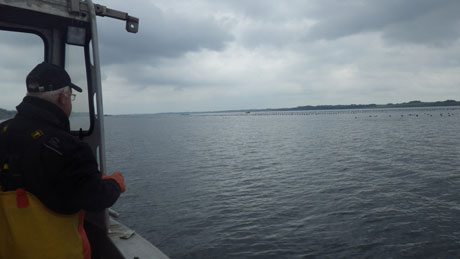
Skive farm buoy up: sampling with Aquaculture Technician Helge Boesen, Danish Shellfish Centre onboard Miss Fischer.
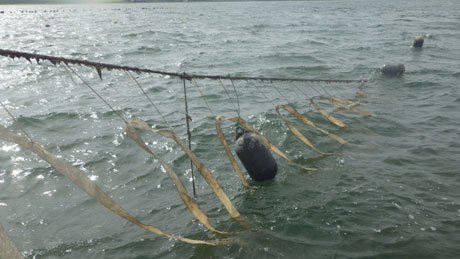
Spat collectors deployment in Sallingsund.
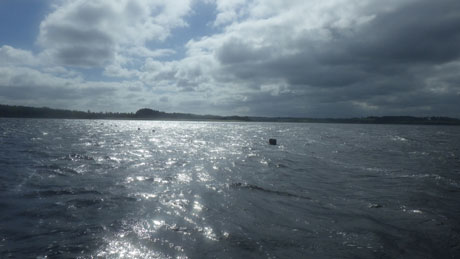
Single line of spat collectors in Mariager Fjord.
12 January 2017
MuMiPro project kickoff
The four-year Innovation Fund Denmark MuMiPro kickoff was on the 12 January 2017. The project has a total budget of 2,9 million EUR and includes 15 partners from Denmark and Norway both from academia and industry. The project is coordinated by Danish Shellfish Centre, DTU Aqua.